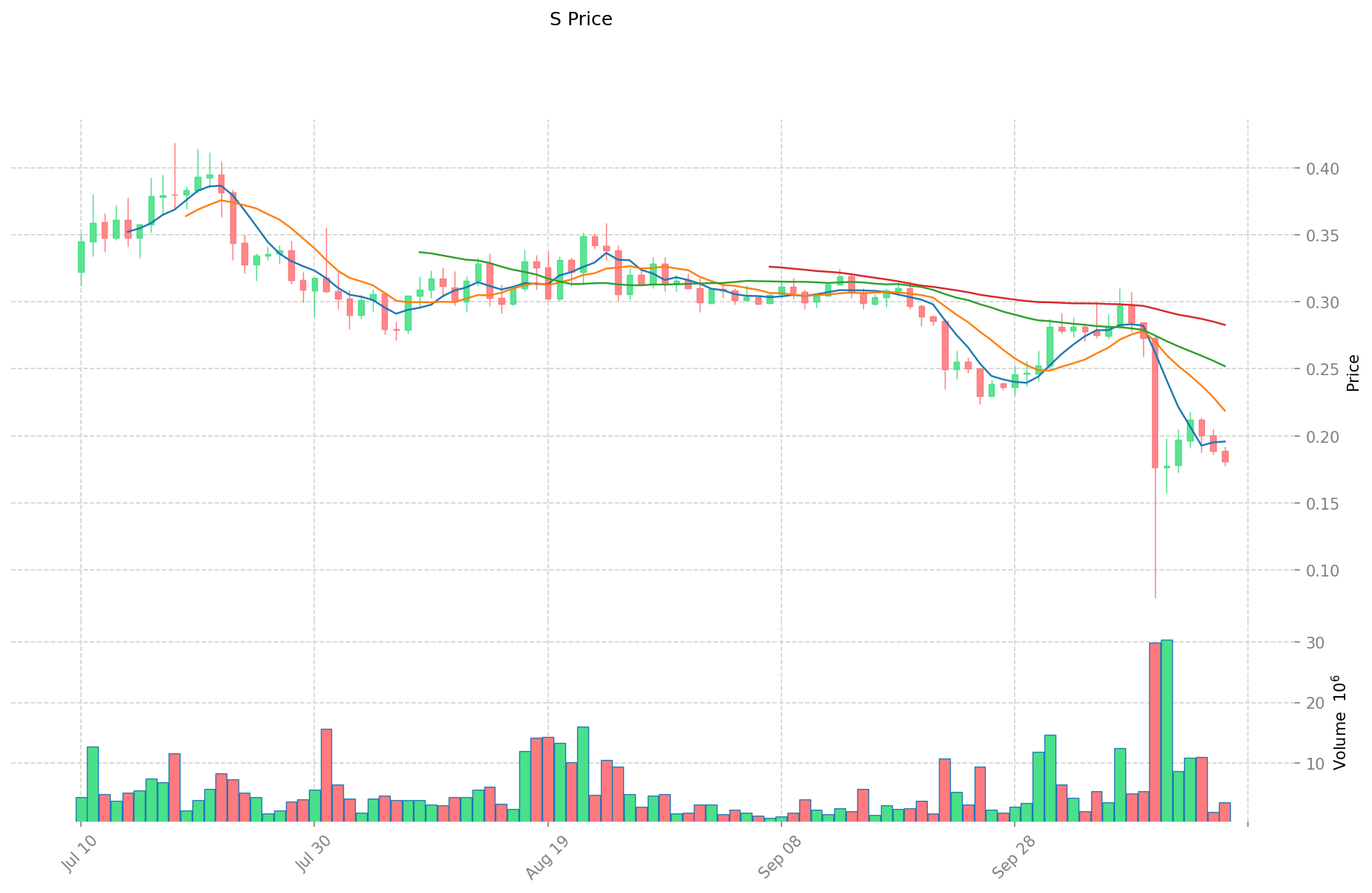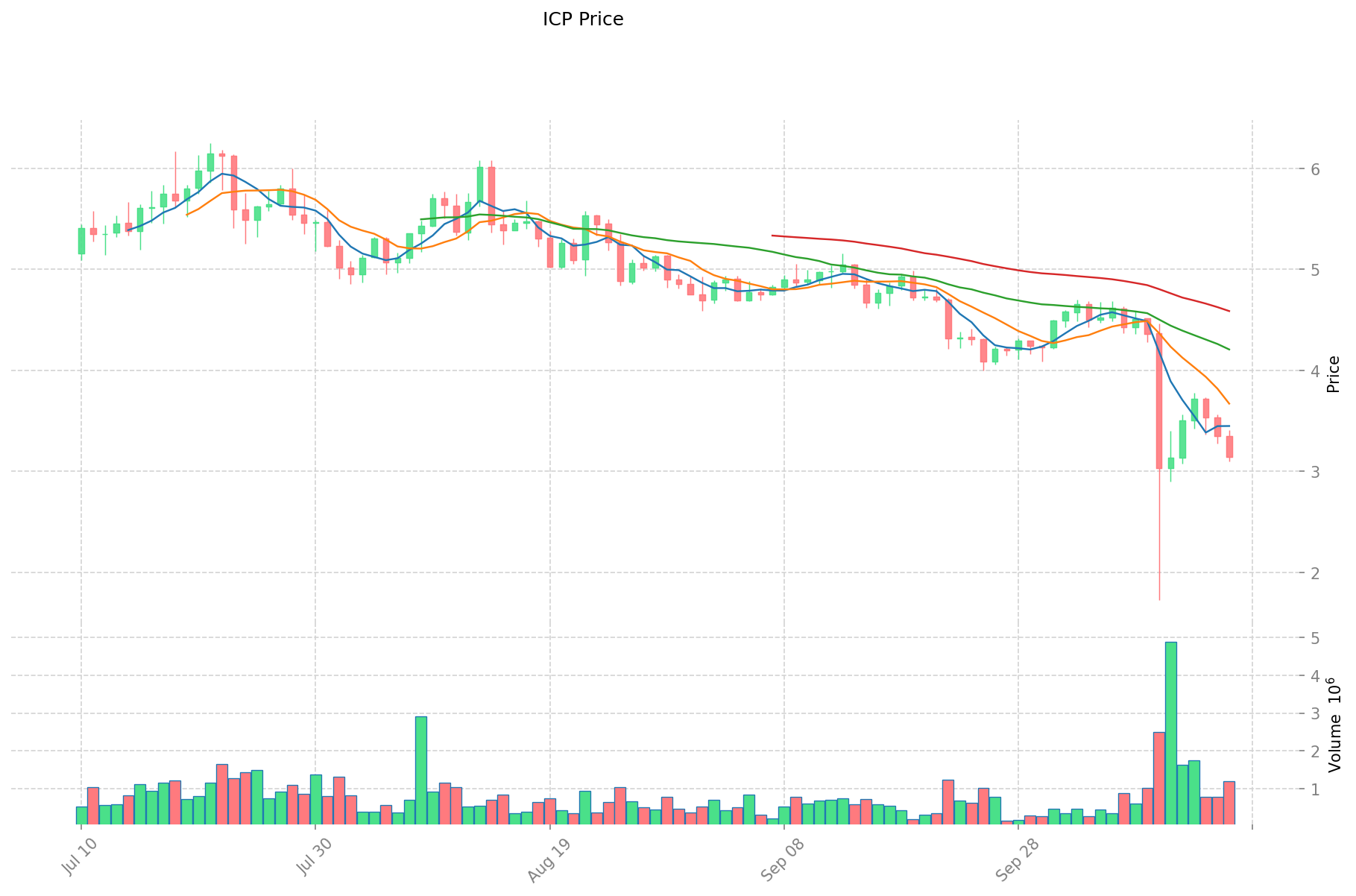S vs ICP: The Battle for Dominance in Cryptocurrency Protocols
Introduction: Investment Comparison of S vs ICP
In the cryptocurrency market, the comparison between Sonic (S) and Internet Computer (ICP) has always been an unavoidable topic for investors. The two not only show significant differences in market cap ranking, application scenarios, and price performance, but also represent different positioning in crypto assets.
Sonic (S): Since its launch, it has gained market recognition for its EVM L1 platform offering attractive incentives and powerful infrastructure for DeFi.
Internet Computer (ICP): Since its inception, it has been hailed as the "World Computer" that can run any online system or service entirely on-the-blockchain, and is one of the cryptocurrencies with the highest global trading volume and market capitalization.
This article will comprehensively analyze the investment value comparison between S and ICP, focusing on historical price trends, supply mechanisms, institutional adoption, technological ecosystems, and future predictions, attempting to answer the question that investors care about most:
"Which is the better buy right now?"
I. Price History Comparison and Current Market Status
Sonic (S) and Internet Computer (ICP) Historical Price Trends
- 2025: Sonic (S) experienced significant price volatility, reaching an all-time high of $1.029 and a low of $0.089.
- 2025: Internet Computer (ICP) saw its price decline, dropping from previous highs to current levels around $3-4.
- Comparative analysis: In the recent market cycle, Sonic (S) dropped from its high of $1.029 to a current price of $0.181, while ICP declined from its all-time high of $700.65 to current levels around $3.134.
Current Market Situation (2025-10-17)
- Sonic (S) current price: $0.181
- Internet Computer (ICP) current price: $3.134
- 24-hour trading volume: S $636,151.58 vs ICP $3,863,827.66
- Market sentiment index (Fear & Greed Index): 28 (Fear)
Click to view real-time prices:
- View S current price Market Price
- View ICP current price Market Price


The Value of Secondary Funds and GP-led Secondary Transactions
I. Core Factors Impacting the Investment Value of Secondary Funds
Liquidity and Capital Circulation
- Secondary funds create essential market liquidity, enabling capital to circulate more efficiently
- They provide exit options for LPs facing liquidity constraints, especially as funds approach maturity
- The massive existing private equity assets create significant opportunities for secondary transactions
Valuation Challenges and Pricing Factors
- Valuation remains a fundamental challenge in secondary transactions due to:
- Lack of public market pricing for private equity assets
- Diverse and subjective valuation methodologies
- Absence of widely accepted valuation standards in China
- Value-to-price ratio is a critical factor determining overall secondary fund performance
- Overpaying for target assets can significantly impact returns and performance
From Zombie Fund Resolution to Active Portfolio Management
- GP-led secondary transactions have evolved from being primarily used to resolve "zombie funds"
- Now recognized as strategic tools for active portfolio management
- Increasingly important as additional exit channels beyond traditional IPO and M&A options
- Growing acceptance in mature markets, where GP-led transactions now account for approximately half of all secondary market volume
II. Market Development Trends of Secondary Funds
Global Market Growth
- Global secondary market transactions exceeded $100 billion for the first time in 2021, reaching $132 billion
- Despite economic fluctuations, the market maintained resilience with $108 billion in transactions in 2022
- Major participants like Coller Capital, HarbourVest Partners, and Lexington Partners have evolved from small funds to multi-billion dollar vehicles
China's Secondary Market Evolution
- 2020 marked a turning point for China's secondary market development
- Pre-2020: Occasional, sporadic transactions driven by immediate liquidity needs
- Post-2020: Strategic adoption of secondary transactions, with increasing sophistication
- Explosive growth in recent years with continuously high growth rates
- Projections suggest China's secondary transaction market will reach at least 1.3 trillion yuan by 2030
The Rise of GP-led Secondary Transactions
- In mature markets, GP-led transactions have grown dramatically since 2020
- Now account for approximately half of all secondary market transactions globally
- Still emerging in China, where LP-led transactions remain dominant
- GP-led transactions demonstrate remarkable resilience and growth even during economic downturns
- Market participants increasingly recognize their value beyond liquidity provision
III. Strategic Considerations for PE/VC Fundraising and Exit Planning
Addressing Industry Challenges
- Secondary transactions help address persistent industry challenges:
- Fundraising difficulties
- Excessive focus on hot sectors
- Insufficient post-investment management
- Exit challenges
Optimizing Existing Assets
- China's private equity industry has entered an era of optimizing existing assets
- Secondary market development signals industry maturation
- Provides solutions for funds approaching their termination dates (particularly those established in 2010-2013)
New Exit Strategies
- Secondary transactions offer alternative exit paths beyond traditional IPO and M&A routes
- Particularly valuable in current market conditions with narrowing IPO channels
- Enables more predictable exit timelines compared to volatile public markets
- Helps mitigate the growing "exit difficulty" challenge facing private equity firms
As China's private equity industry continues to mature, secondary funds and particularly GP-led secondary transactions will become increasingly important tools for both liquidity provision and active portfolio management.
III. 2025-2030 Price Prediction: S vs ICP
Short-term Prediction (2025)
- S: Conservative $0.132 - $0.181 | Optimistic $0.181 - $0.239
- ICP: Conservative $1.885 - $3.142 | Optimistic $3.142 - $3.613
Mid-term Prediction (2027)
- S may enter a growth phase, with estimated price range $0.205 - $0.270
- ICP may enter a growth phase, with estimated price range $2.618 - $5.583
- Key drivers: Institutional capital inflow, ETF, ecosystem development
Long-term Prediction (2030)
- S: Base scenario $0.211 - $0.359 | Optimistic scenario $0.359 - $0.513
- ICP: Base scenario $3.312 - $5.614 | Optimistic scenario $5.614 - $6.737
Disclaimer
S:
| 年份 | 预测最高价 | 预测平均价格 | 预测最低价 | 涨跌幅 |
|---|---|---|---|---|
| 2025 | 0.239316 | 0.1813 | 0.132349 | 0 |
| 2026 | 0.29022504 | 0.210308 | 0.11146324 | 16 |
| 2027 | 0.2702878416 | 0.25026652 | 0.2052185464 | 38 |
| 2028 | 0.366990824928 | 0.2602771808 | 0.16918016752 | 43 |
| 2029 | 0.40458786369456 | 0.313634002864 | 0.23836184217664 | 73 |
| 2030 | 0.51352863458937 | 0.35911093327928 | 0.211875450634775 | 98 |
ICP:
| 年份 | 预测最高价 | 预测平均价格 | 预测最低价 | 涨跌幅 |
|---|---|---|---|---|
| 2025 | 3.6133 | 3.142 | 1.8852 | 0 |
| 2026 | 4.323392 | 3.37765 | 3.2763205 | 7 |
| 2027 | 5.58325545 | 3.850521 | 2.61835428 | 22 |
| 2028 | 6.1319546925 | 4.716888225 | 4.150861638 | 50 |
| 2029 | 5.8041309608625 | 5.42442145875 | 3.3088970898375 | 73 |
| 2030 | 6.7371314517675 | 5.61427620980625 | 3.312422963785687 | 79 |
IV. Investment Strategy Comparison: S vs ICP
Long-term vs Short-term Investment Strategy
- S: Suitable for investors focused on DeFi ecosystems and EVM compatibility
- ICP: Suitable for investors interested in Web3 infrastructure and decentralized cloud computing
Risk Management and Asset Allocation
- Conservative investors: S: 30% vs ICP: 70%
- Aggressive investors: S: 60% vs ICP: 40%
- Hedging tools: Stablecoin allocation, options, cross-currency portfolios
V. Potential Risk Comparison
Market Risk
- S: Higher volatility due to smaller market cap and newer project status
- ICP: Susceptible to broader market trends and competition in the blockchain infrastructure space
Technical Risk
- S: Scalability, network stability
- ICP: Decentralization concerns, potential security vulnerabilities
Regulatory Risk
- Global regulatory policies may have differing impacts on both assets
VI. Conclusion: Which Is the Better Buy?
📌 Investment Value Summary:
- S advantages: Strong DeFi ecosystem, attractive incentives, EVM compatibility
- ICP advantages: Established infrastructure project, higher market cap, broader application potential
✅ Investment Advice:
- New investors: Consider a balanced approach with a slight bias towards ICP for its established position
- Experienced investors: Explore opportunities in S's DeFi ecosystem while maintaining exposure to ICP
- Institutional investors: Diversify across both assets, with a focus on ICP for its infrastructure play and S for potential growth
⚠️ Risk Warning: The cryptocurrency market is highly volatile. This article does not constitute investment advice. None
VII. FAQ
Q1: What are the main differences between Sonic (S) and Internet Computer (ICP)? A: Sonic (S) is an EVM L1 platform focused on DeFi with attractive incentives, while Internet Computer (ICP) is a broader blockchain infrastructure project aiming to run online systems and services entirely on-chain. S has a smaller market cap and is newer, while ICP is more established with a larger market cap.
Q2: Which cryptocurrency has shown better price performance recently? A: Based on recent data, Sonic (S) has shown more volatility and potential for growth, reaching an all-time high of $1.029 in 2025 before settling at $0.181. ICP, on the other hand, has seen a decline from its all-time high of $700.65 to current levels around $3.134.
Q3: What are the long-term price predictions for S and ICP by 2030? A: For Sonic (S), the base scenario predicts a range of $0.211 - $0.359, with an optimistic scenario of $0.359 - $0.513. For ICP, the base scenario predicts $3.312 - $5.614, with an optimistic scenario of $5.614 - $6.737.
Q4: How should investors allocate their assets between S and ICP? A: Conservative investors might consider allocating 30% to S and 70% to ICP, while aggressive investors might opt for 60% S and 40% ICP. The exact allocation depends on individual risk tolerance and investment goals.
Q5: What are the main risks associated with investing in S and ICP? A: For S, key risks include higher volatility due to its smaller market cap, scalability issues, and network stability. For ICP, risks involve susceptibility to broader market trends, competition in the blockchain infrastructure space, and potential security vulnerabilities.
Q6: Which cryptocurrency is better suited for long-term vs. short-term investment? A: S may be more suitable for investors focused on DeFi ecosystems and EVM compatibility, potentially offering higher short-term gains but with more volatility. ICP might be better for those interested in long-term investment in Web3 infrastructure and decentralized cloud computing.
Q7: How do regulatory risks affect S and ICP? A: Both S and ICP are subject to regulatory risks, but the impact may differ. Global regulatory policies could affect both assets, but ICP's broader infrastructure focus might make it more resilient to certain regulatory changes compared to S's more specific DeFi focus.
Share
Content